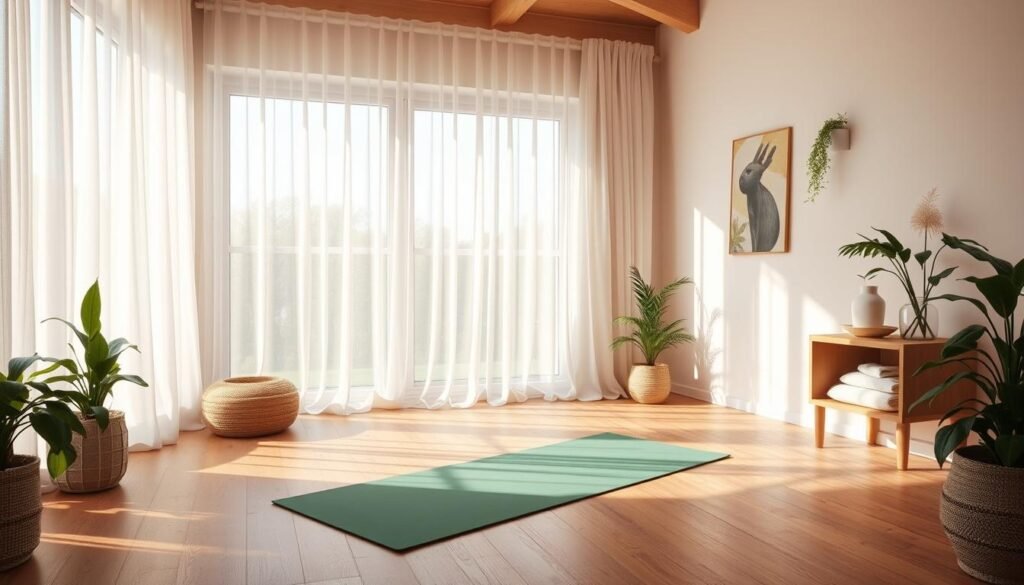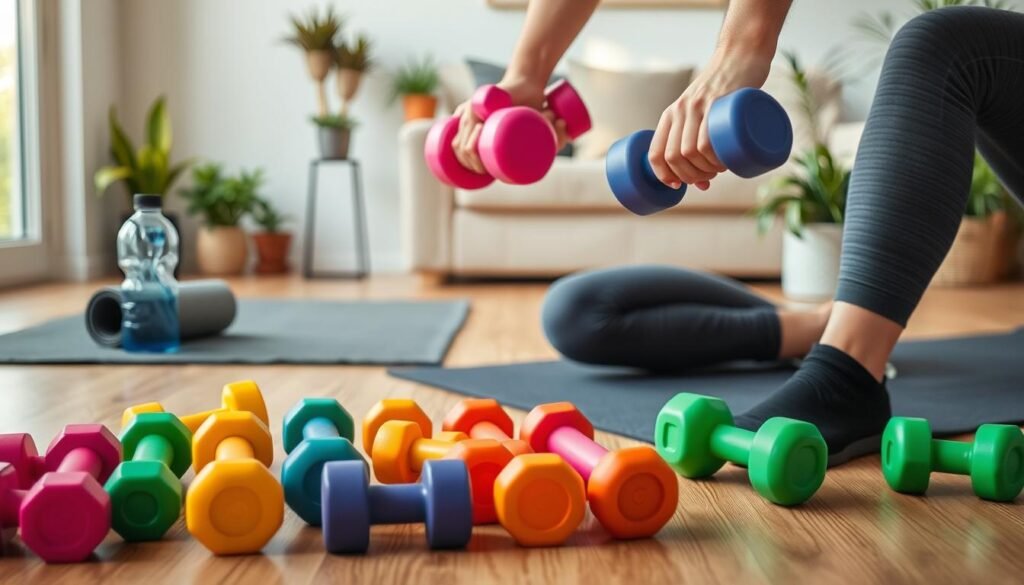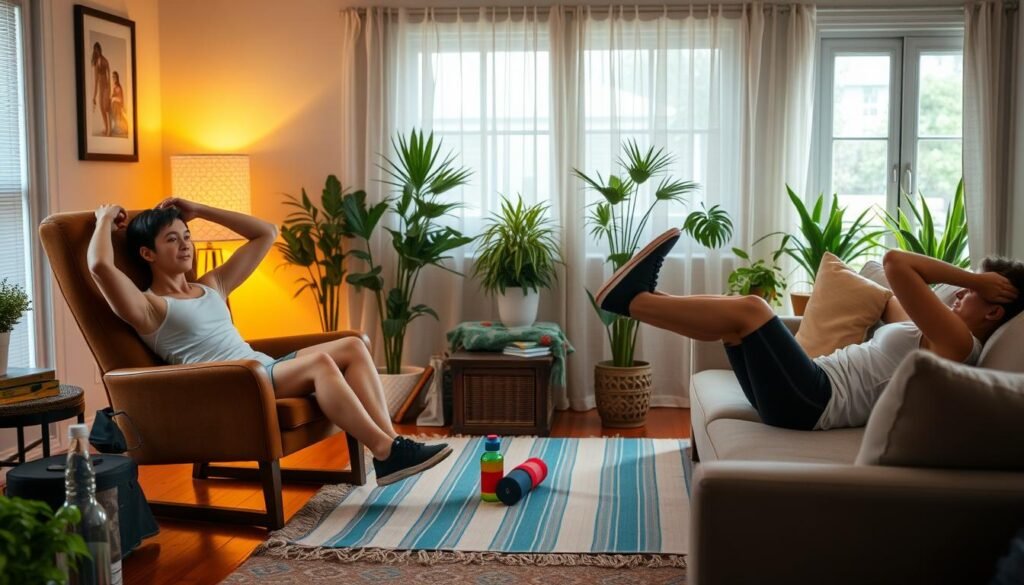Did you know nearly 75% of people feel less anxious after just 30 minutes of exercise? This statistic shows how powerful home workouts can be in handling anxiety and boosting mental health. Exercising at home can release endorphins, which are the body’s natural mood lifters.
Simple workouts at home can lower anxiety and boost overall health. You don’t need fancy equipment or to travel far. With easy exercises like yoga or strength training, you can create a workout plan that fits your daily life. This can greatly improve both your body and your mind.
For more on how exercise helps with anxiety and the connection between your mind and body, visit exercise and anxiety management.
Key Takeaways
- Home workouts can significantly reduce anxiety levels and improve mood.
- Physical activity stimulates the release of endorphins, enhancing mental well-being.
- Even short bouts of exercise can lead to notable stress relief.
- Creating a structured routine at home eliminates the need for gym memberships.
- Accessibility and convenience make at-home workouts suitable for any schedule.
- Minimal equipment is often needed, making these workouts cost-effective.
Understanding the Connection Between Exercise and Anxiety
Many people have noticed how exercise impacts anxiety. Studies show that being active helps ease anxiety symptoms. This happens because exercise lowers stress hormones and boosts mood-enhancing ones.
There are many ways to be active. You can run, practice yoga, or take quick walks. These activities lower stress and help us feel mentally balanced. The U.S. Department of Health suggests 150 minutes of activity per week. Even a little exercise can greatly improve how we feel mentally.
Simply walking can lift your mood, studies say. Regular activity fights anxiety and depression by releasing feel-good chemicals. It also keeps our minds off worries. This shows just how crucial regular exercise is for our mental health.
It’s important to understand the link between exercise and anxiety for a better life. Exercising regularly has lasting mental health benefits. Making it a daily habit can cut down anxiety and make us happier.
The Science of Exercise-Induced Mood Enhancement
Working out causes interesting changes in the brain. These changes are mainly because of endorphins, which reduce pain and boost happiness. Studies show that exercising for 15 to 30 minutes can make you feel better and less anxious. Exercise is a great way to manage stress and improve mental health.
People who exercise regularly feel happier and less depressed. Exercise lowers stress, fights off sadness, improves confidence, and helps you sleep better. It’s not just good for your mood; it also makes your heart stronger, gives you more energy, and improves how you look. Trying different activities, like biking, dancing, or yoga, is good for both your mind and body. Those who work out four or five times a week see even bigger benefits.
Exercise can also fight depression, offering a natural treatment choice. Active people are less likely to be depressed than those who aren’t active. A 2006 study review showed exercise is a strong way to deal with depression. It found that staying active can reduce signs of depression over time. For those who often feel panicked, exercise can help calm them down.
According to research, committing to regular exercise improves how well you handle anxiety. It proves to be a powerful way to improve your overall well-being.
No Gym, No Problem: Effective Home Workouts
Home workouts are great for managing anxiety without a gym. They use bodyweight exercises in a safe place. This promotes mental and physical health. These workouts are easy to do anytime, making fitness accessible to all.
Bodyweight Exercises as a Solution
Bodyweight exercises are perfect for home workouts. They fit all skill levels, from beginners to advanced athletes. You can do exercises like:
- Assisted Bodyweight Squats
- Push-ups
- Dumbbell Rows
- Knee Planks
- Bodyweight Good Mornings
Beginners can start with simple routines. For instance, two circuits of 10 squats and 10 knee push-ups. More advanced routines include one-legged squats and jump step-ups for challenge.
HIIT Workouts for Quick Anxiety Relief
HIIT Workouts are popular for quick fitness. They mix short, intense exercises with rest. This is great for reducing anxiety quickly. For example, you might do:
- Jumping Jacks – 30 reps
- Bodyweight Squats – 20 reps
- Push-ups – 10 reps
- Plank – 30 seconds
These workouts boost heart health and mood. They release endorphins during the intense parts. Changing up routines keeps things exciting and encourages sticking with it.
| Workout Level | Circuits | Exercises Included |
|---|---|---|
| Beginner Bodyweight Workout | 2 | Assisted Squats, Knee Push-ups, Dumbbell Rows, Knee Planks |
| Beginner Bodyweight Level 2 | 3 | Bodyweight Squats, Push-ups, Walking Lunges, Plank |
| Advanced Bodyweight Workout | 3 | One-legged Squats, Walking Lunges, Jump Step-ups |
| Hotel Workout Level 1 | 1 | Bodyweight Squats, Incline Push-ups, One-arm Rows |
| Attack of the Angry Birds Workout | 1 | Jumping Jacks, Bodyweight Squats, Push-ups |
Staying committed to No-Equipment Training helps improve health and mood. It makes fitness an enjoyable daily activity.
Mindful Movements: Yoga and Meditation at Home
Adding yoga and meditation to daily life can greatly boost emotional health. Doing Yoga at Home lets people reconnect with their bodies. It also helps increase mindfulness and awareness. These practices bring inner peace and make fighting anxiety easier.
Incorporating Breathing Techniques
Breathing techniques are key in improving yoga and meditation. Using pranayama helps with relaxation and sharpens focus. This makes handling stress easier. Focusing on breathing calms the parasympathetic nervous system. This brings peace and lowers anxiety.
The Benefits of Mindful Stretching
Mindful stretching does more than make you flexible. It eases body tension and stress. Practicing Yoga at Home involves mindful stretches. These help both mental and physical health. Studies show mindful movements boost energy and focus. They also build resilience.
Through mindful stretching, people can tell apart good and bad body sensations. This knowledge can prevent injuries during workouts.

The Power of Cardio: Indoor Running and Walking
Running at home and walking for fitness are great for our minds and bodies. The CDC says we need 150 minutes of exercise like this every week. Walking is perfect for all fitness levels and helps calm our nerves.
Start with brisk walking at 3 to 3.5 mph. Those who are more active might try going faster, around 4.5 mph. The Borg Scale helps you figure out how hard you’re working. Aiming for a score of 13 to 14 means you’re doing it right. Running and walking both help lower the risk of health issues like high blood pressure and diabetes. But, you might have to walk longer to burn the same calories as running.
Try mixing in intervals and walking uphill to up the challenge and burn more calories. Walking two minutes after meals helps control blood sugar levels. And, don’t forget, comfy shoes are key for any indoor cardio. Walking is gentle on your body but great for your heart and stress levels.
Indoor running or walking boosts your heart health and lifts your mood by releasing endorphins. Adding these exercises to your routine helps manage stress and keep you healthy.
Dumbbell Workouts: Building Strength and Confidence
Dumbbell workouts are great for beginners to start strength training. They’re simple and boost both physical strength and confidence. By working all major muscle groups, one can feel better about themselves. This helps lower anxiety.

Simple Dumbbell Routines for Beginners
Starting with dumbbells is easy if you have the right plan. Here are some basic exercises that don’t need a lot of gear:
| Exercise | Sets | Reps | Rest Time |
|---|---|---|---|
| Dumbbell Romanian Deadlift | 3 | 8 | 90 seconds |
| Dumbbell Bench Press | 3 | 8 | 90 seconds |
| Dumbbell Reverse Lunge | 3 | 12 (each leg) | 90 seconds |
| Single-arm Bent-over Dumbbell Row | 3 | 12 (each arm) | 90 seconds |
| Dumbbell Heels-elevated Goblet Squat | 3 | 15 | 90 seconds |
| Dumbbell Curl | 3 | 10 | 90 seconds |
These dumbbell workouts build strength and allow for easy progress. Workout two to three times a week. Increase reps gradually until you hit three sets of 12. With these exercises, you grow both physically and mentally.
For more about dumbbell workouts at home, check out this resource. It has tips to make your routine suit you while keeping it fun.
Resistance Band Training for a Full-Body Workout
Resistance bands are a great choice for a full-body workout at home. They’re cheap and work for all fitness levels. You can work out many muscles safely, which helps lower stress.
Creating a Home Resistance Band Routine
For beginners, a simple plan with seven resistance band exercises works well. Do these exercises 2 to 5 times a week. They help build strength and are relaxing too.
- Squats
- Chest Press
- Seated Rows
- Shoulder Press
- Deadlifts
- Tricep Extensions
- Lateral Band Walks
Plan your workouts over five days for enough rest. More advanced exercises might push this to six days.
The LIT AXIS™ system tracks your workout details. It tells you about your reps, how hard you work, and workout time. This helps make each session better for muscle and strength.
| Week | Workout Days | Type of Training |
|---|---|---|
| 1 | 5 | Strength-Based |
| 2 | 5 | Strength-Based |
| 3 | 6 | Advanced Strength |
Research shows resistance bands make you more balanced and flexible. They also tire your muscles more than traditional workouts. Using different bands for various muscles leads to the best strength gains.
Living Room Workouts: Creative Approaches to Exercise
Living Room Workouts make fitness fun with Creative Fitness. They use things you find at home to build exercise routines. Without a gym, you get to be more creative. You can turn parts of your home, like living rooms or offices, into perfect spots for Home Exercise.
A starter routine includes ten basic bodyweight moves. Think squats and push-ups. You do 10 to 15 reps of each, resting for 30 seconds to a minute between them. This whole routine takes about 15 to 20 minutes, ideal for newcomers to exercising. Later, as you get better, try adding more reps slowly, focusing on good form to avoid getting hurt.
You only need a small space, roughly 8-10 square feet, for these exercises. You can use things like backpacks filled with books or laundry detergent bottles for extra weight. Even a simple pouf can turn into equipment for exercises like burpees.
When times are tough, having a workout routine helps fight against stress and worry. Setting goals that you can achieve little by little helps keep up Creative Fitness. Working out every day improves your mood and keeps you motivated to stay healthy.
To find more ways to work out at home, there are free online resources with different fitness classes. Check out these home workout options. They offer a wide range of activities to keep indoor fitness fun and effective.
| Fitness Level | Exercise Type | Reps/Sets | Rest | Time |
|---|---|---|---|---|
| Beginner | Bodyweight Exercises | 2 sets of 10-15 | 30 sec – 1 min | 15-20 min |
| Intermediate | Mixed Body Exercises | 2 sets of 10-15 | 1 min | 20-25 min |
| Advanced | Timed Rounds | 1 min each, twice | None | Select your duration |

Social Aspect of At-Home Fitness: Virtual Classes and Groups
The way we work out at home has changed a lot. People can now find friends online who share their fitness goals. This has been super important when we can’t meet others, keeping us going and connected.
Joining online fitness classes makes people feel part of a team. They share tips and push each other. This not only works out the body but also helps the mind. When regular gyms close, virtual workouts become a popular way to stay fit and feel together.
A lot of different workout groups have popped up. They offer everything from yoga to intense training. So, no matter what you like, there’s a group for you. It’s a great way to meet people who like the same activities.
Virtual classes give us new ways to workout together. Companies like Peloton and Supernatural have built big communities this way. People cheer each other on, stick to their fitness plans, and make new friends.
In conclusion, being part of a fitness community online really helps. It drives us to keep up with our workouts and adds fun to the process. These online friendships make us feel we belong, blending our fitness goals with the joy of being together.
Conclusion
Home workouts have become a great way for people to improve their mental health and handle anxiety. They fit well with different lifestyles. You can find an activity that works for you and do it whenever you like. Doing exercises at home, like yoga or bodyweight workouts, makes it easy to keep going without leaving your house.
Exercising regularly is key to feeling mentally strong. Without gym costs or travel time, many find home exercises help reduce anxiety. They also feel better overall. Adjusting your workouts to fit your home helps make a calm and focused space. For tips on setting up your routines, click here.
Even though there might be distractions, the benefits of working out at home motivate many. It’s important to be flexible and try different exercises, such as using resistance bands or practicing deep breathing. Sticking to a home exercise plan can really help manage anxiety. It’s a step towards a healthier way of life.